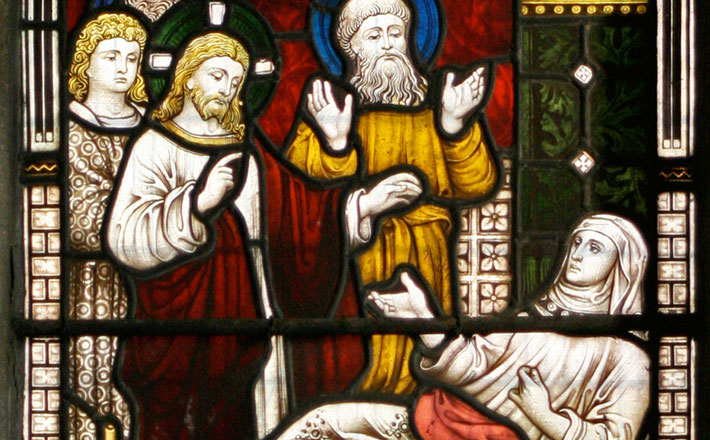Commentary on Mark 1:29-39
This passage continues the one assigned for last week.
As soon as Jesus and his few followers leave the Capernaum synagogue, they enter Simon’s house. There they encounter Simon’s mother-in-law, who lies ill with a fever.
Wide-ranging ministry
The exorcism occurred in a synagogue, a more public setting than this private home. The exorcism involved a man; now Jesus will deliver a woman. Mark does not suggest the woman’s ailment is demonic, but we shouldn’t underestimate the seriousness of a fever, either; in a world without antibiotics, her condition may prove fatal, depending on the circumstances.
Taken together, then, Jesus’ two deeds in Mark 1:21-31 stake out a range. Different kinds of settings involving different kinds of people suffering different kinds of problems — Mark implies that Jesus’ ministry of deliverance has widespread influence, with potential to benefit all kinds of people. Mark reiterates this wide scope as the current passage progresses, as Jesus heals and delivers everyone with a need in Capernaum and then sets out for other places across Galilee.
Service and gender
There’s something about Mark 1:31 that makes audiences bristle. Why is the healed woman’s first response to serve Jesus and his four disciples? When we learn that “serve” translates diakoneo, most likely indicating food service, and means she “waited on” them, it doesn’t help. Why didn’t Simon tell his mother-in-law to take it easy while he made sandwiches this time?
Yes, preachers explain in breathless attempts to explain away the discomfort, indeed that little detail matters. But it means only to indicate that the woman was fully healed at once. What a miracle — no recuperation period needed!
Or: yes, she served the men, but her service was a way of showing respect and gratitude to her healer. Maybe she was also serving God as a means of doing so. Jesus always commends humble service and describes himself as one who came to serve (diakoneo; 10:45) — what a faithful response!
Yes, the explanations continue, in that culture it would have been shameful for a woman in a household to neglect a guest. To feed Jesus would have honored him, but it would also have restored the woman’s own honor and dignity. Healed, she could do what her society expected her to do and what her fever had prevented her from doing. She was set free!
All of these responses are true, but they still exacerbate the frustration generated by this aspect of Mark 1:31. The woman’s appropriate response is to serve? Appropriate in whose eyes? Wouldn’t true healing and liberation allow her to take on other roles? After all, when Jesus raises Lazarus from the dead in John 11, Lazarus doesn’t respond with service. He reclines at a dinner table in John 12:2 while his sister Martha “serves” (diakoneo). Jesus’ healing of the mother-in-law and the miracle’s outcome remain indelibly gendered, and gendered in ways that veer too close to the stereotypes we know to be tired and destructive.
Is more possible from this unnamed woman? Is more possible for her? That depends on how fertile a preacher’s imagination may be. It won’t do to castigate Mark or the ancient gender roles that made this story sound normal or appropriate to its original audiences (at least probably to most of the men in those audiences). A preacher might instead open up new horizons of opportunity and agency for Simon’s mother-in-law.
Those looking for possibilities in the biblical material itself might jump ahead to Mark 15:40-41. There, as Jesus’ corpse hangs from a Roman cross, Mark finally lets us in on the secret that the crowd of Jesus’ regular disciples includes more than twelve men. We learn there about a group of women who watched Jesus’ execution “from a distance” while all the rest of Jesus’ followers had fled at his arrest (14:50) and Simon was last seen weeping in a courtyard (14:72). Not all of these women are named, so we know little about them. Still, we learn that they “provided for [Jesus] when he was in Galilee.” The verb the NRSV translates as “provided for” in 15:41? It’s diakoneo. Maybe Simon’s mother-in-law is among the serving women who observe the crucifixion.
If she’s among them, then she’s more than a cook, waiter, and dishwasher. She’s also a follower.
If she’s a follower, and a follower who is willing to serve as she goes (unlike the oafish James and John in 10:35-45), then she’s also a disciple.
If she’s a disciple, then to her “has been given the secret of the kingdom of God” (Mark 4:11).
Proclaiming and enacting the reign of God
The verses at the end of this passage deserve attention, especially given the liturgical setting of Epiphany. How will Jesus become noticed? Through what means will he manifest himself to the world?
Mark presents us with a Jesus who chooses to remain remote but also seeks to stay on the move. He prays in an isolated place and eludes the crowds, but then he goes on to other areas, because he understands his purpose as “proclaiming.” Mark repeatedly indicates that “proclaiming” or “preaching” for Jesus goes beyond words and messages. It includes his exorcisms, healings, and legal controversies. It involves all the ways in which he makes God’s reign (or “kingdom,” as traditionally translated) known and observable. His preaching activity, the full range of his public ministry, is performative and effective: it demonstrates what God’s reign looks like, and it has real effects as it delivers people, heals people, restores people to community, forgives people, and speaks truth to power.
It is this preaching’s nature not to stay settled and rooted in a single place among a fixed audience but to seek new settings and opportunities to express itself.
The point is not that Jesus must fix everything or everyone in Galilee before he will be arrested. In Mark, he only heals those who present themselves to him. He never appears to go out in search of problems to remedy; they find him. This prompts the question of what exactly he intends to accomplish, before all is done.
As the gospel story progresses, he will be more than a healer. He will need to, for he seems unable to keep pace with the incredible demand that human need places upon him. So he will commission others to assist in his work. And he will travel. And he will persist. And, in the end, he will pay a price for his determination to inaugurate God’s reign.
Therefore, he also, like Simon’s mother-in-law, will be “lifted up” (cf. Mark 1:31 and 16:6).


February 8, 2015